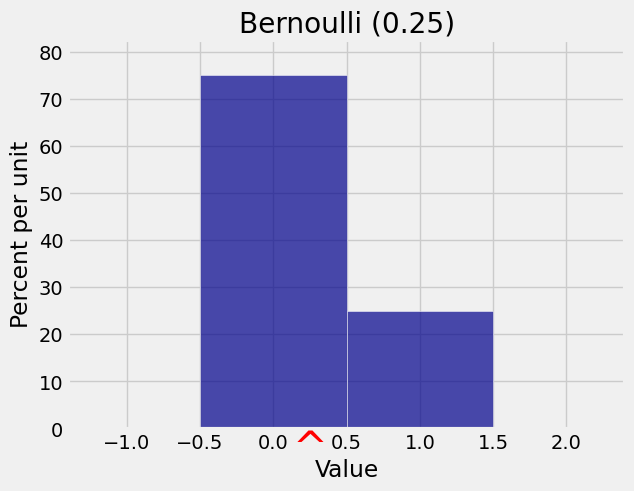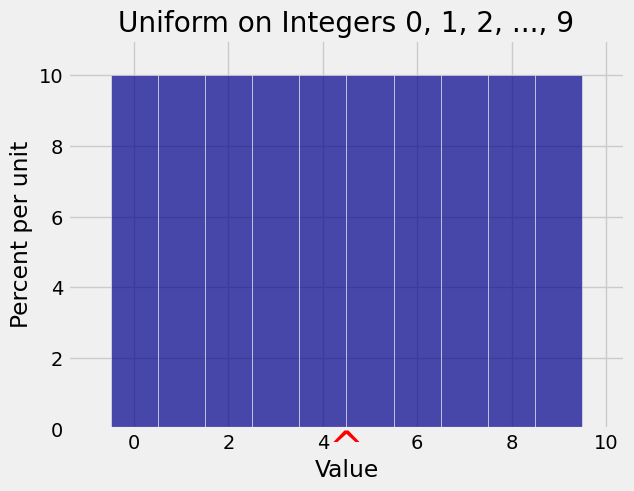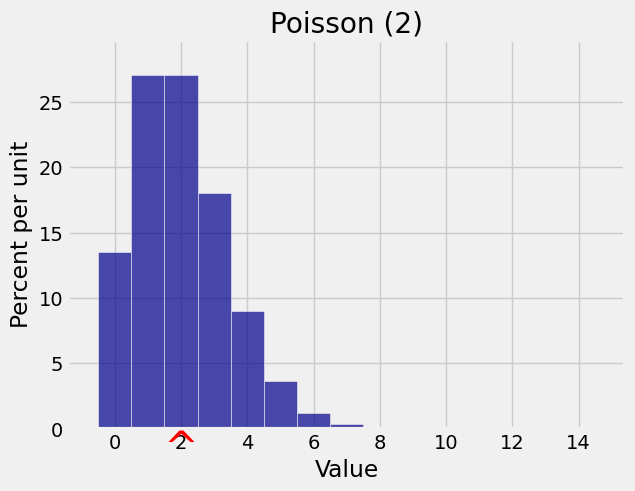8.2. Applying the Definition#
Now that we have a few ways to think about expectation, let’s see why it has such fundamental importance. We will start by directly applying the definition to calculate some expectations. In subsequent sections we will develop more powerful methods to calculate and use expectation.
8.2.1. Constant#
This little example is worth writing out because it gets used all the time. Suppose a random variable
8.2.2. Bernoulli and Indicators#
If
As you saw earlier, zero/one valued random variables are building blocks for other variables and are called indicators.
Let
by our calculation above. Thus every probability is an expectation. We will use this heavily in later sections.
x = [0, 1]
qp = [0.75, 0.25]
bern_1_3 = Table().values(x).probabilities(qp)
Plot(bern_1_3, show_ev=True)
plt.title('Bernoulli (0.25)');

Quick Check
Three coins are tossed. Let
Answer
8.2.3. Uniform on an Interval of Integers#
Let
For example, if
An instance of this is if
If instead
x = np.arange(10)
probs = 0.1*np.ones(10)
unif_10 = Table().values(x).probabilities(probs)
Plot(unif_10, show_ev=True)
plt.title('Uniform on Integers 0, 1, 2, ..., 9');

Quick Check
Let
(i)
(ii)
(iii)
Answer
(ii)
See More
8.2.4. Poisson#
Let
We now have an important new interpretation of the parameter of the Poisson distribution. We saw earlier it was close to the mode; now we know that it is also the balance point or expectation of the distribution. The notation
k = np.arange(15)
poi_2_probs = stats.poisson.pmf(k, 2)
dist_poi_2 = Table().values(k).probabilities(poi_2_probs)
Plot(dist_poi_2, show_ev=True)
plt.title('Poisson (2)');

Quick Check
Let
(a) If you simulate
(b) The most likely value of
(c)
Answer
(a) True
(b) True
(c) False
See More
8.2.5. Tail Sum Formula#
To find the expectation of a non-negative integer valued random variable it is sometimes quicker to use a formula that uses only the right hand tail probabilities
For non-negative integer valued
Rewrite this as
Add the terms along each column on the right hand side to get the tail sum formula for the expectation of a non-negative integer valued random variable.
This formula comes in handy if a random variable has tail probabilities that are easy to find and also easy to sum.
8.2.6. Geometric#
In a sequence of i.i.d. Bernoulli
Let
This is called the geometric
The right tails of
The formula is also true for
By the tail sum formula,
See More
Quick Check
Find the expectations of the following random variables.
(a) The number of rolls of a die till the face with six spots appears
(b) The number of rolls of a die till a face with more than four spots appears
(c) The number of times a coin is tossed till it lands heads
Answer
(a) 6
(b) 3
(c) 2

